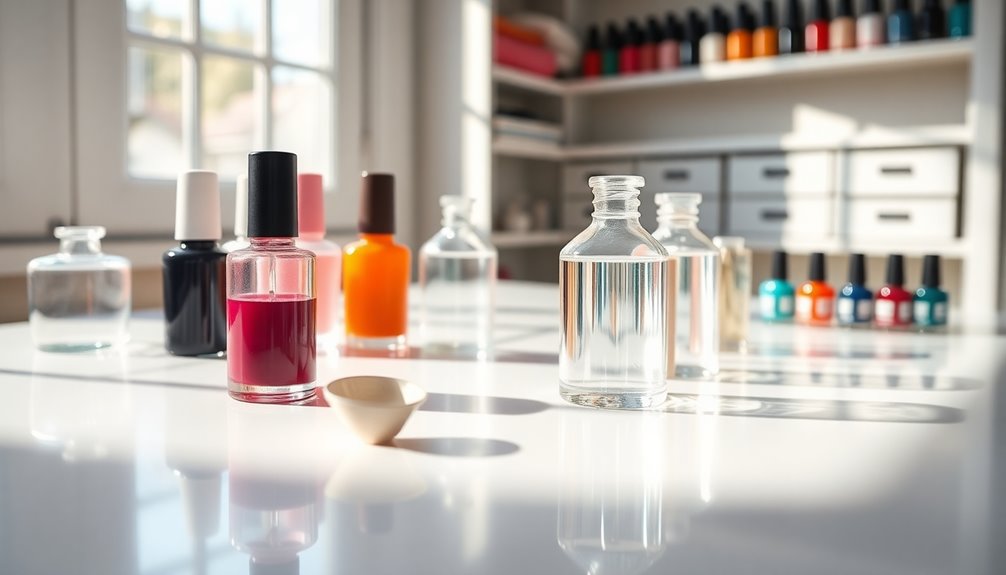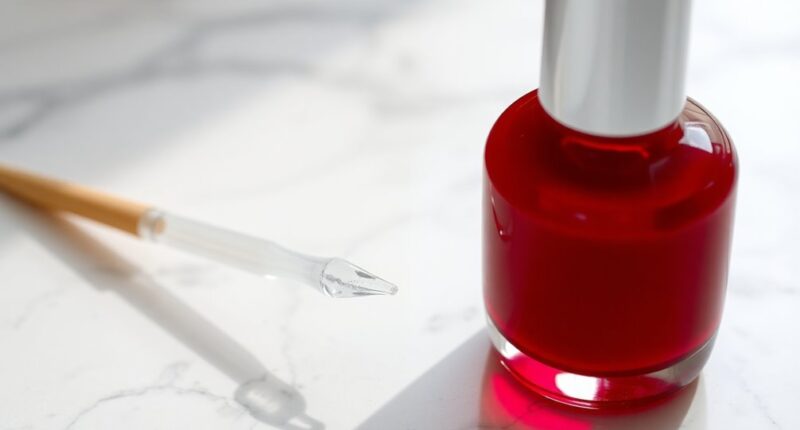To thin nail polish, soak the bottle in hot water for two minutes to improve consistency. If it's clumpy, add 2-3 drops of nail polish thinner or one drop of pure acetone, then roll the bottle gently. Avoid shaking to prevent air bubbles. Store polish in a cool, dry place and seal tightly after each use to maintain its quality. There are more tips to help keep your polish in top shape and prevent thickening.
Key Takeaways
- Soak the polish bottle in hot water for 2 minutes to improve consistency for slightly thick polish.
- Add 2-3 drops of nail polish thinner and roll the bottle gently to mix for clumpy polish.
- Start with one drop of pure acetone if using it as a thinning agent, mixing gently.
- Store nail polish in a cool, dry place to prevent thickening and clumping over time.
- Tightly seal polish bottles after each use and clean the neck regularly to maintain a good seal.
Thinning Out Slightly Thick Nail Polish

If you find your nail polish has become slightly thick over time, you can easily fix it with a simple method.
Start by filling a bowl with hot water and soak the polish bottle for about 2 minutes. This warms the formula and helps improve consistency.
After soaking, gently roll the bottle between your palms instead of shaking it, as shaking can create air bubbles that lead to a clumpy mess.
Once you've rolled the bottle, check the consistency by applying a small amount on a nail. If it still feels thick, you can repeat the process for a better result. Additionally, maintaining the balance between power and responsibility in your nail care routine can ensure your products remain effective and enjoyable to use.
Thinning Out Clumpy Nail Polish

When your nail polish gets clumpy, using a nail polish thinner is your best bet—just add about two drops and roll the bottle to mix.
If you don't have thinner, a single drop of pure acetone can work, but be careful not to overdo it.
Always check the consistency after each addition to guarantee a smooth application. Additionally, maintaining essential oils for hair growth can help keep your nails healthy and reduce clumping from dryness.
Nail Polish Thinner Usage
To restore clumpy nail polish and achieve a smooth application, using nail polish thinner is vital.
Start by adding 2-3 drops of thinner to the bottle; this helps maintain the polish's integrity. After adding, roll the bottle gently between your palms to shake the bottle and guarantee thorough mixing without air bubbles.
Check the consistency after each addition, as excessive thinner can reduce adhesion. If the polish still feels thick, you can repeat the process, but be cautious not to add too much at once. Additionally, using a thinner that is specifically designed for nail polish can greatly enhance the filtration efficiency of your formula, ensuring optimal results.
Acetone as Last Resort
Sometimes, despite your best efforts with nail polish thinner, you might find yourself facing stubbornly clumpy polish. In such cases, acetone can serve as a last resort, but use it sparingly.
Here's how to do it effectively:
- Add a single drop of acetone using an eyedropper.
- Gently swirl the bottle to mix the thinner.
- Test the polish on a nail to verify it reaches a desirable consistency.
Remember, this is just a temporary solution. While acetone can thin out clumpy nail polish, it may compromise its quality over time, causing it to look bumpy or dull. Always opt for polish thinner first to maintain your polish's integrity. Additionally, maintaining the correct nail shape preference can enhance the overall appearance of your manicure.
Using Nail Polish Thinner

Nail polish thinner is your go-to solution for restoring the perfect consistency of thickened polish.
To use it, simply add a few drops directly into the polish bottle. Then, roll it between your palms to mix thoroughly, avoiding shaking to prevent air bubbles.
Start with a small amount; excessive thinner can compromise the polish's adhesion and performance.
Regular nail polish thinners are compatible with most formulas, but always check for compatibility with specialty polishes like gel or glitter.
Investing in thinner not only helps restore the consistency of your favorite polishes but also prolongs their life, saving you money in the long run compared to frequently purchasing new bottles. Additionally, maintaining a clean filter in your air purifier can enhance the air quality in your workspace, allowing you to focus better on your nail art projects.
Adding Acetone or Nail Polish Remover

When you're adding acetone or nail polish remover, start with just a single drop to avoid ruining the polish's formula. After each drop, swirl the bottle gently to mix and check if the consistency meets your needs. Remember, regular filter replacement is essential for maintaining the effectiveness of air purifiers, similar to how consistency is crucial for nail polish applications.
Acetone Usage Tips
Although you might be tempted to grab the acetone right away, it's essential to use it carefully for thinning nail polish. Start with just a single drop, as adding too much can quickly degrade the quality of your polish.
Here are some tips to keep in mind:
- Use an eyedropper for precise drops.
- Gently swirl the bottle to mix after each addition.
- Check the consistency after every drop to avoid over-thinning.
- Always test the thinned polish on a small area before full application. Additionally, be aware that saturated fat intake can affect overall health, so consider how your nail care routine fits into your lifestyle choices.
Limitations of Remover
While adding acetone or nail polish remover may seem like a quick fix for thinning polish, it's crucial to recognize the limitations of these substances.
Using acetone as a thinning agent can temporarily restore flow, but it often breaks down the polish's formula, compromising its longevity. This can lead to a bumpy or dull finish over time, reducing wearability.
Additionally, excessive use may shorten the lifespan of your polish, damaging essential components. Nail polish remover is generally less effective than dedicated thinners, which replace evaporated solvents without causing harm.
Be cautious, especially with glitter polishes, as they may not respond well to acetone and are often better replaced rather than thinned. Furthermore, being aware of the sugar content in products used alongside nail care can help in making healthier choices overall.
Mixing Techniques Explained
Given the limitations of using remover, it's important to know how to mix acetone or nail polish remover effectively when attempting to thin your polish. Follow these steps to guarantee the best results:
- Add only a single drop of acetone at a time.
- Swirl the polish gently to mix thoroughly.
- Check the polish's consistency after each drop.
- Avoid excessive use of acetone, as it can dull or bump your polish.
Ideally, consider using a nail polish thinner, as it's specifically designed to restore the polish's original viscosity without degrading its quality. This careful mixing process will help you achieve a smoother polish consistency while preserving its integrity. Additionally, it's crucial to remember that just like good oral hygiene habits can prevent future dental issues, maintaining the right consistency in your nail polish can enhance its longevity and performance.
Proper Storage Techniques

To keep your nail polish in top condition, it's important to store it properly. Always store nail polish in a cool place, away from direct sunlight, as this can break down the formula. Avoid the bathroom due to humidity, which can accelerate thickening. If you live in a hot or humid climate, consider refrigeration to reduce solvent evaporation.
Here's a quick reference table for proper storage:
| Storage Tip | Benefit |
|---|---|
| Keep bottles upright | Prevents polish from flowing into the neck |
| Tightly sealed after use | Minimizes air exposure |
| Regularly check seals | Extends lifespan |
Following these storage techniques will help you maintain your polish's quality and guarantee it lasts longer. Additionally, consistent maintenance of your products can prevent costly repairs and replacements.
Preventing Nail Polish From Thickening

If you want to keep your nail polish from thickening, proper storage is essential. Here are some tips to guarantee your polish stays in great condition:
- Store nail polish in a cool, dry place away from humidity.
- Make sure each bottle is tightly sealed after use to minimize air exposure.
- Avoid storing nail polish in bathrooms where steam can accelerate thickening.
- Consider refrigerating nail polish in hot or humid climates for consistent cool temperatures.
Additionally, track the purchase dates of your nail polishes and discard any that become too thick or show signs of separation.
Tips for Maintaining Nail Polish

Maintaining your nail polish is essential for ensuring it stays usable and looks great. Here are some key tips to help you keep your polishes in top shape:
| Tip | Action | Benefit |
|---|---|---|
| Store Nail Polish | Keep in a cool, dry place | Prevent thickening and clumping |
| Seal After Use | Tighten the cap after applying | Minimize air exposure |
| Track Purchase Dates | Write down when you buy each polish | Monitor shelf life |
| Avoid Humidity | Don't store in bathrooms | Maintain consistency and longevity |
Expert Insights and Reader Tips

While keeping your nail polish in good condition is essential, expert insights and reader tips can provide additional strategies for thinning it effectively.
- Use nail polish thinner as the preferred thinning method to revive thick nail polish without compromising quality.
- Be cautious with nail polish remover; while it can thin, it may damage the polish.
- Choose specialized thinners that are compatible with older polishes to avoid adverse chemical reactions.
- Regularly clean the neck of your nail polish bottle to maintain a tight seal, preventing air exposure that contributes to thickening.
Frequently Asked Questions
How Can I Thin My Nail Polish at Home?
If you find your nail polish getting thick, there are simple ways to fix it at home.
You can add a few drops of nail polish thinner directly into the bottle and roll it between your palms to mix.
Alternatively, try submerging the closed bottle in hot water for a couple of minutes.
If you're in a pinch, a single drop of pure acetone can work too—just be careful not to overdo it!
Is It OK to Thin Nail Polish With Nail Polish Remover?
It's not ideal to thin nail polish with remover, especially if it contains acetone.
While it might seem like a quick fix, it can actually degrade the polish's quality and lead to a dull, uneven finish.
If you choose to use remover, only add a drop at a time.
For better results, consider using a nail polish thinner, as it's specifically designed to maintain the polish's integrity without compromising its performance.
How to Make Nail Polish Liquid Again?
Ever found yourself struggling with a stubborn nail polish?
To make it liquid again, try adding a few drops of nail polish thinner designed for this purpose. If that's not available, a drop of pure acetone can work, but be careful!
You can also warm the bottle in hot water for a couple of minutes.
Finally, rolling the bottle between your palms can help mix it up without ruining the formula.
Can I Use Rubbing Alcohol to Thin Nail Polish?
Yes, you can use rubbing alcohol to thin nail polish. Just add about two drops to the bottle and mix it well.
Keep in mind that its effectiveness can vary based on the polish formula, so you might need to experiment a bit.
After adding the alcohol, let the polish settle before using it.
Always test the consistency on a nail first to guarantee it meets your needs for application.
Conclusion
With a little care, your once-thick nail polish can glide on like a silky breeze, transforming your nails into a vibrant canvas. By mastering the art of thinning and storing your polishes, you'll guarantee that every stroke is smooth and every color shines bright. So, embrace these handy tips, keep your collection fresh, and watch as your nails become a stunning reflection of your creativity. After all, a well-cared-for polish is a masterpiece waiting to happen.









